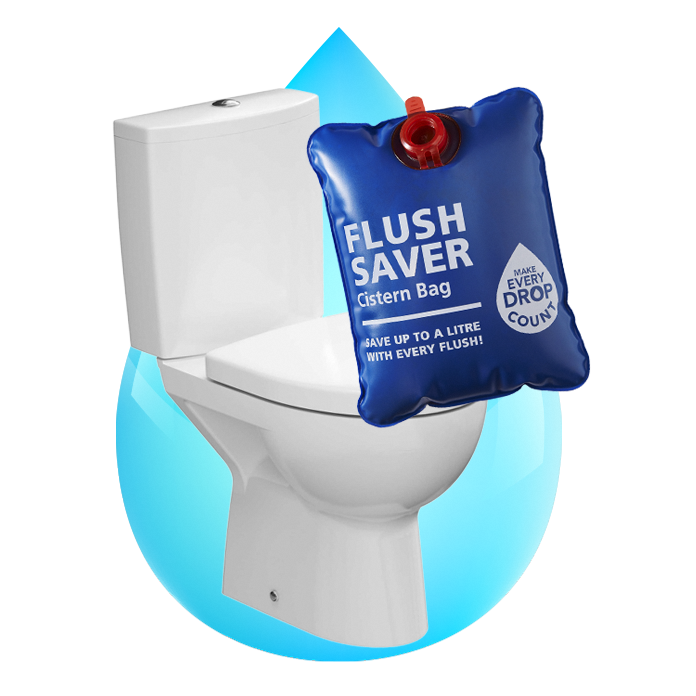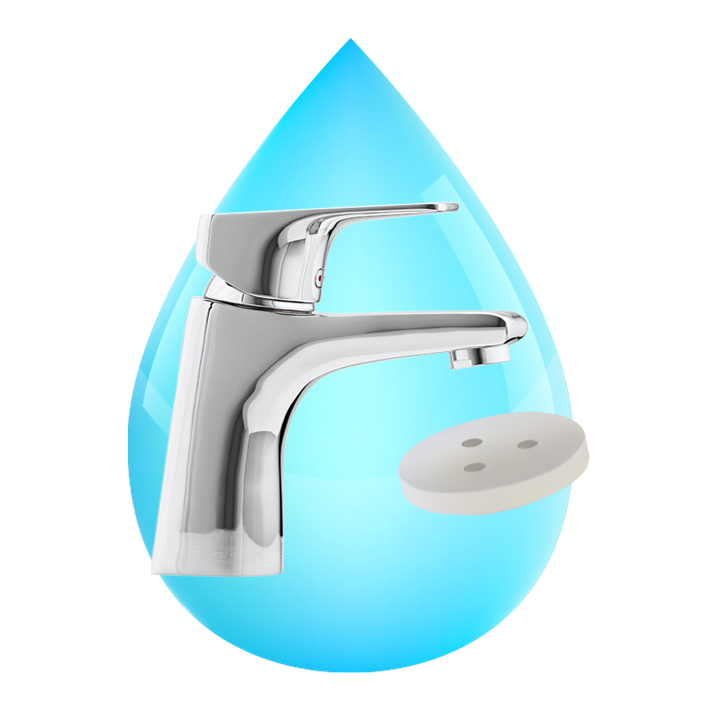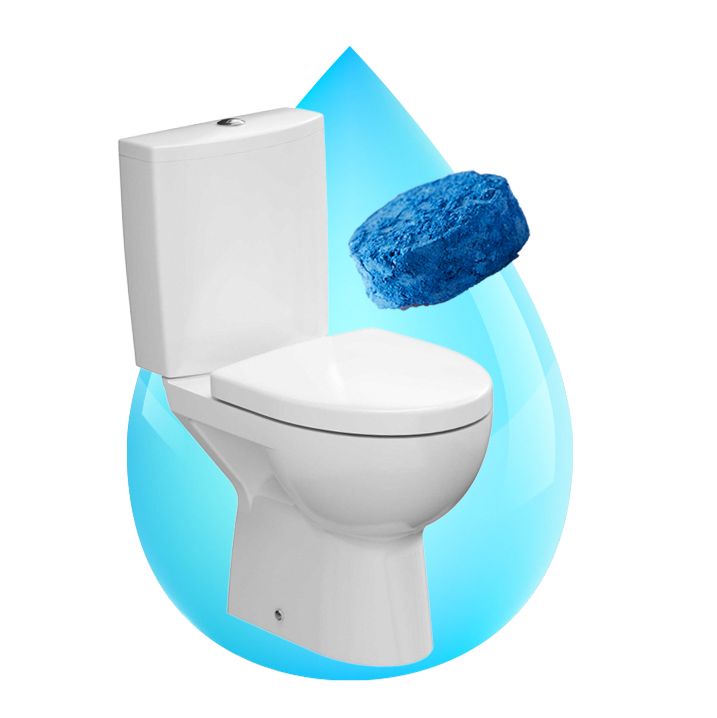Showering, flushing, kitchen and laundry make up about 80% of the average household’s total water usage.
These water saving items help households to use water more efficiently when doing these daily activities – flush saver cistern bags for flushing cisterns, leak detection tablets, as well as thimbles for shower heads, kitchen and bathroom sink taps.
Find out how these items help you save water and if they are suitable for your household.
Save up to a litre with every flush by placing a flush saver cistern bag in your flushing cistern.

Households with flushing cisterns below the Mandatory Water Efficient Labelling Scheme (WELS) 2-tick ratings purchased before 2019 are recommended to request for a flush saver cistern bag.
If your flushing cistern is concealed or inaccessible, you will not need the flush saver cistern bag.
Watch the video to learn how to install:
Regulate the flow rate of taps and showerheads in your home with the water saving thimbles and save up to 5% of your monthly consumption.

Households with taps below the Mandatory Water Efficient Labelling Scheme (WELS) 2-tick ratings and/or do not have thimbles are recommended to request for thimbles.
Households can determine their flow rate of taps and check against the MWELS tick rating. Users can determine the flow rate with the following method:
Watch the video to learn how to install:
Use leak detection tablets to identify silent leaks, which could incur more than 10 litres of water wastage per hour.

If you suspect one, use these tablets to confirm the presence of a leak in the flushing cistern
Watch the video to learn how to use:
Save up to a litre with every flush by placing a flush saver cistern bag in your flushing cistern.

Households with flushing cisterns below the Mandatory Water Efficient Labelling Scheme (WELS) 2-tick ratings purchased before 2019 are recommended to request for a flush saver cistern bag.
If your flushing cistern is concealed or inaccessible, you will not need the flush saver cistern bag.
Watch the video to learn how to install:
Regulate the flow rate of taps and showerheads in your home with the water saving thimbles and save up to 5% of your monthly consumption.

Households with taps below the Mandatory Water Efficient Labelling Scheme (WELS) 2-tick ratings and/or do not have thimbles are recommended to request for thimbles.
Households can determine their flow rate of taps and check against the MWELS tick rating. Users can determine the flow rate with the following method:
Watch the video to learn how to install:
Use leak detection tablets to identify silent leaks, which could incur more than 10 litres of water wastage per hour.

If you suspect one, use these tablets to confirm the presence of a leak in the flushing cistern
Watch the video to learn how to use:
You can install the flush saver cistern bag into the flush cistern tank on your own with these simple steps:
Before you begin:
Installation:
A plumber is not necessary as the thimbles can be installed in both showerheads and taps in 4 easy steps:
The shelf life of thimbles can vary based on the frequency of use and the conditions of use and storage. Thimbles that are not installed should be kept in a dry and cool place.
Regular cleaning and inspection for signs of wear or damage can help to ensure that the thimbles remain effective in reducing water consumption.
The leak detection tablets identify leaks by providing a visual indication as they dissolve in the flushing cistern tank. When the toilet bowl has traces of blue-coloured water, it means a leak is present and you should call a licensed plumber to fix or replace the flushing cistern.
Licensed plumbers (LPs) are professionals who are licensed by PUB to ensure they maintain good standards of regulated water service and sanitary works. LPs are required to adhere to technical requirements, safety, water quality, and water conservation guidelines set by PUB when carrying out these works. Homeowners and service hirers need to ensure that they only employ LPs through credible platforms for their regulated water service and sanitary plumbing works. Public can refer to PUB’s website for a list of LPs: https://go.gov.sg/licensed-plumbers-info.
If you suspect a leak in your flushing cistern, use a leak detection tablet to confirm it. However, leaks can occur in other areas of your home such as at taps or appliances using water. You can spot signs of a leak by:
Household members can first visually check for leaks through the presence of water streaks entering the toilet bowl, and the “ripple” effect of water in the toilet bowl.
Households can refer to this infographic for more tips on how to identify leaks in their homes: https://go.gov.sg/tipsonfindingleaks.
Before you begin:
Putting in the tablet:
Observing the results:
Households should always engage a licensed plumber who is qualified to detect and repair leaks.
You can find a list of licensed plumbers at https://go.gov.sg/licensed-plumbers-info.
You can install the flush saver cistern bag into the flush cistern tank on your own with these simple steps:
Before you begin:
Installation:
A plumber is not necessary as the thimbles can be installed in both showerheads and taps in 4 easy steps:
The shelf life of thimbles can vary based on the frequency of use and the conditions of use and storage. Thimbles that are not installed should be kept in a dry and cool place.
Regular cleaning and inspection for signs of wear or damage can help to ensure that the thimbles remain effective in reducing water consumption.
The leak detection tablets identify leaks by providing a visual indication as they dissolve in the flushing cistern tank. When the toilet bowl has traces of blue-coloured water, it means a leak is present and you should call a licensed plumber to fix or replace the flushing cistern.
Licensed plumbers (LPs) are professionals who are licensed by PUB to ensure they maintain good standards of regulated water service and sanitary works. LPs are required to adhere to technical requirements, safety, water quality, and water conservation guidelines set by PUB when carrying out these works. Homeowners and service hirers need to ensure that they only employ LPs through credible platforms for their regulated water service and sanitary plumbing works. Public can refer to PUB’s website for a list of LPs: https://go.gov.sg/licensed-plumbers-info.
If you suspect a leak in your flushing cistern, use a leak detection tablet to confirm it. However, leaks can occur in other areas of your home such as at taps or appliances using water. You can spot signs of a leak by:
Household members can first visually check for leaks through the presence of water streaks entering the toilet bowl, and the “ripple” effect of water in the toilet bowl.
Households can refer to this infographic for more tips on how to identify leaks in their homes: https://go.gov.sg/tipsonfindingleaks.
Before you begin:
Putting in the tablet:
Observing the results:
Households should always engage a licensed plumber who is qualified to detect and repair leaks.
You can find a list of licensed plumbers at https://go.gov.sg/licensed-plumbers-info.